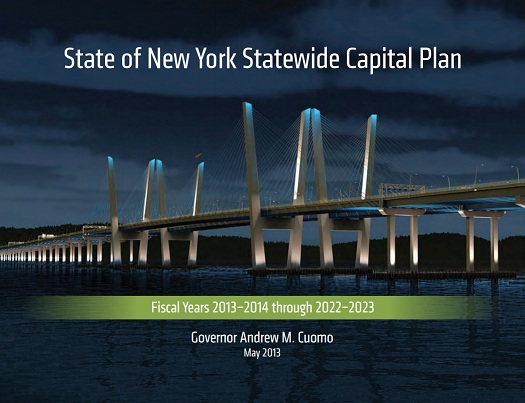
The transportation sector is far and away the largest component of the NY Works Task Force Statewide Capital Plan, anticipating $113.42 billion in spending on transportation over 10 years — 65 percent of the total $174 billion. The plan, considered the first-ever long-term capital plan for the state of New York, proposes capital expenditures that cover the needs of 47 state agencies and authorities.
The plan’s transportation investments are categorized as either “state of good repair,” “capacity optimization” or “transformational initiatives,” with the vast majority of transportation dollars proposed to be spent on state of good repair (78.6 percent or $89.17 billion), though “state of good repair” is not substantially defined beyond stating that it is the “maintenance of existing infrastructure.”
Some transportation highlights include:
MTA
The MTA plans to spend $56 billion in the next ten years. But the Statewide Capital Plan fails to identify funding sources for roughly $28 billion of that spending between 2016-2023.
NYSDOT
NYSDOT’s new strategy of “preservation first” talks about investing in “infrastructure with the right treatment, at the right time in the life of the investment, and in a location that considers the overall travel system.” Unfortunately, the plan anticipates a decreasing chunk of federal dollars to support the system, going from $1.609 billion in FY2014 to $1.225 billion in FY 2023, a decrease that is compensated in the plan by an increase in “pay-as-you-go” state funds.
The combined expenditures of the four upstate transit authorities would be $1.5 billion over 10 years, in addition to the $1.2 billion allocated to the transit, rail aviation and port program through NYSDOT.
Although there are some notable gaps and several blatant political plugs, the 328-page document does a good job of making the connection between the state’s economic vitality and the condition of its infrastructure. The plan clearly points out that poor infrastructure increases the cost of doing business and the stress levels of commuters in New York including that:
- heavy congestion takes a toll, costing motorists an additional $925-$1,568 each year
- poor transit service in the New York City metro area causes 750,000 residents to endure commutes of over an hour
Glaringly missing from the plan are infrastructure costs related to Superstorm Sandy resiliency (which a footnote states are “in the process of being finalized”), bicycle and pedestrian infrastructure, as well as any discussion of the Tappan Zee Bridge replacement, though the plan’s cover page includes an image of the bridge’s new design, and the report includes numerous mentions of the project.
The most important steps remain outstanding, namely the formation of a financing council and a capital investment fund. And unfortunately, the plan only considers capital investments, saying nothing about a long-term plan for the transportation operating needs of the State, especially for the transit authorities.

[…] Extra hurdles often mean projects are less likely to make it to the finish line. Planners throughout the various MPOs, who are already struggling to get more of these projects going with less federal support, worry that a Preservation First approach will short-change pedestrian and bicycling infrastructure. And it’s not the only state policy short-changing vulnerable road users. The vast majority of projects funded through Governor Cuomo’s NY Works program, which is focused on repaving roads and re-building bridges, also do not include new facilities for pedestrians and bicyclists. […]
Good post. I’m facing some of these issues as well..